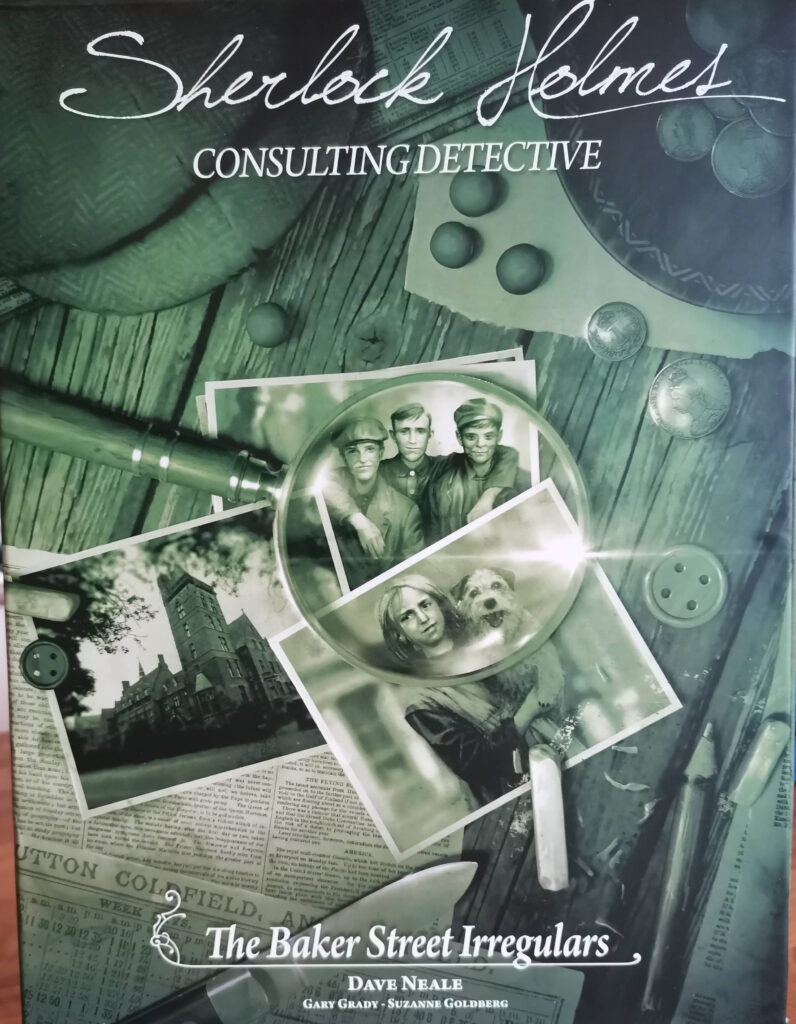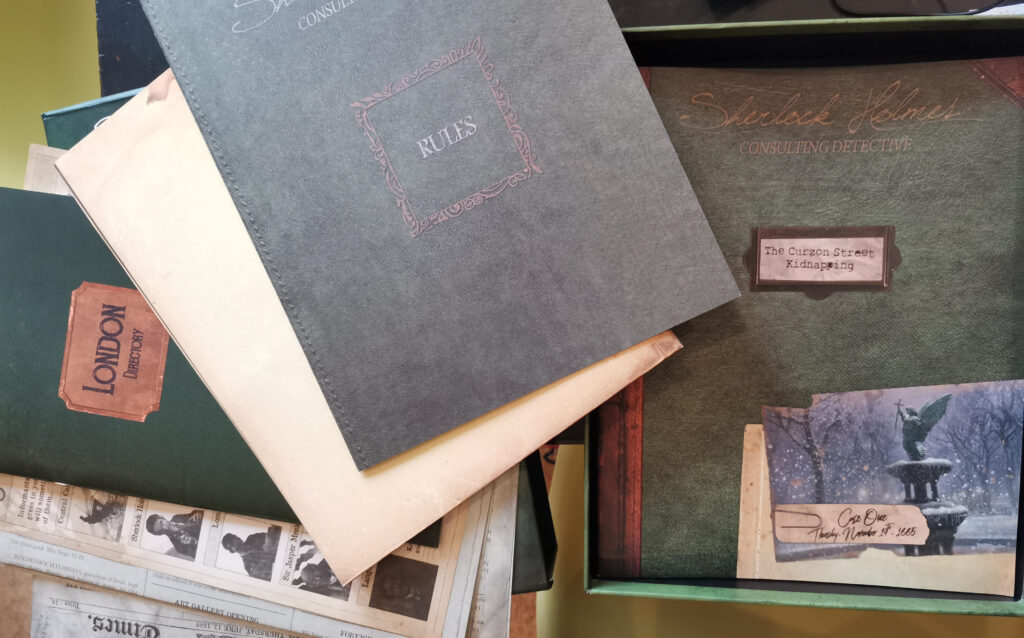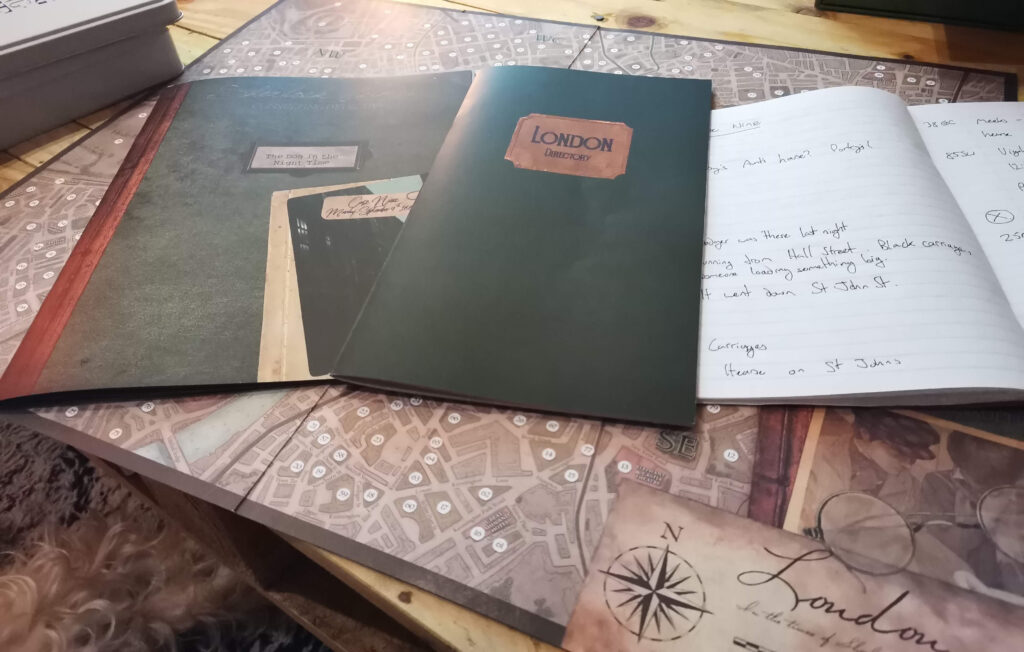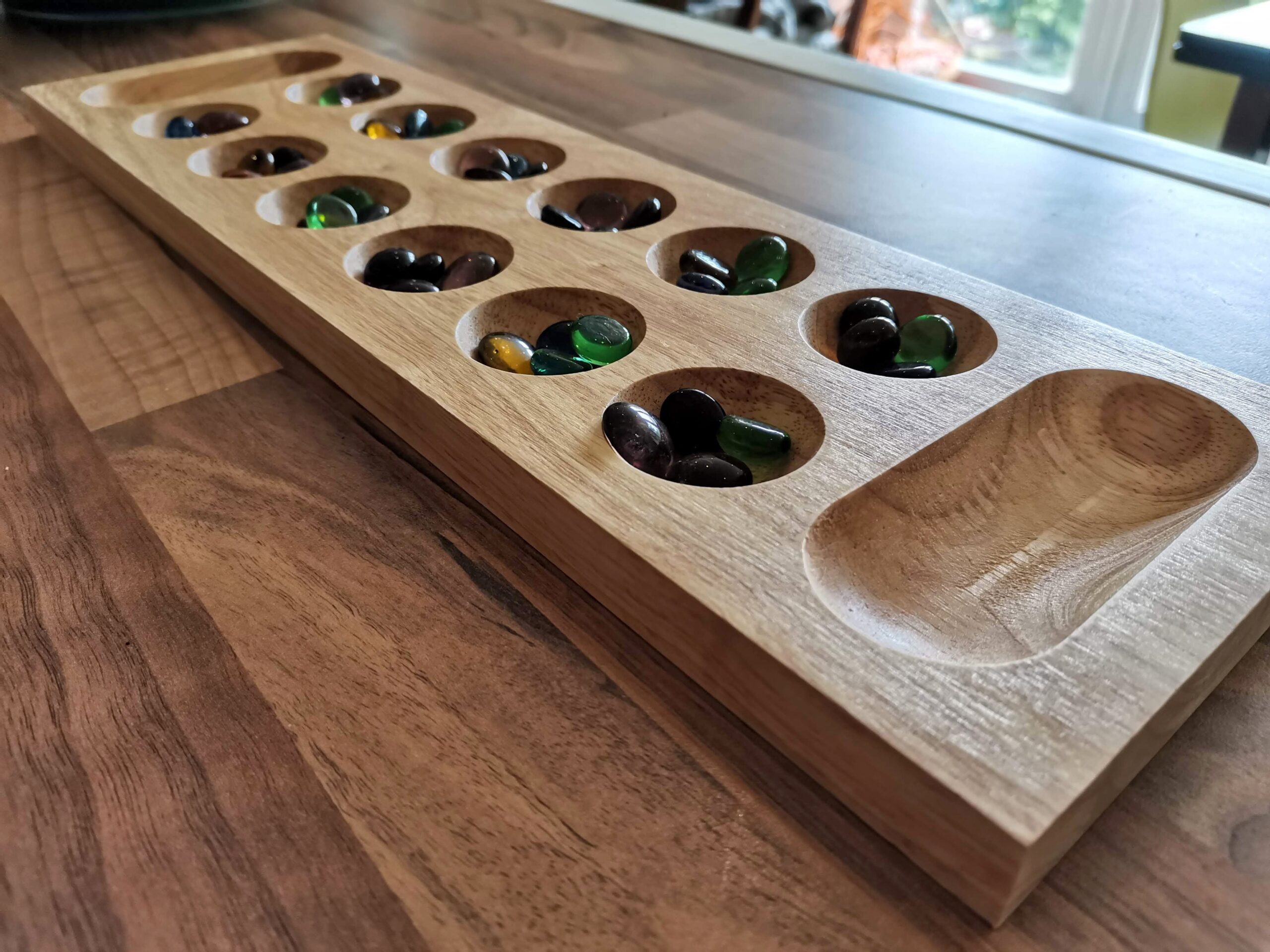The Baker Street Irregulars Review

There’s nothing quite like a good mystery, and we love the detectives in fiction. Miss Marple, Hercules Poirot, Columbo – there are loads, but the best of the lot is Sir Arthur Conan Doyle’s most famous creation, Sherlock Holmes. The Sherlock Holmes Consulting Detective series of games have been around for nearly 40 years now, and this year saw the release of the latest of the bunch – The Baker Street Irregulars. Let’s see how good it is.

The original game came out in 1982, and was a real change from the norm when it came to games. Not a board game in the conventional sense of it, there was no board. Instead the box for that, and all the subsequent games, contains a mixture of books, maps and pages from fictional newspapers. The goal of the games are to read the cases, follow the clues, and solve the mysteries. The game is in how that all happens.
What’s In The Box?
As I mentioned above, there’s no board to speak of, and no cards. The box for The Baker Street Irregulars slides out sideways and inside there are ten case books, ten newspapers, a London directory, a large four-fold map, a contacts sheet, and finally the rule book.

The quality of everything, box included, is really high. By the time I’d finished all ten cases, there was no visible signs of wear on anything, even the map which was folded and unfolded countless times. The paper is luscious and thick, the printing and illustrations are really high-quality, and the whole thing just feels expensive. A lot more expensive than it actually is.
How Does It Play?
Here’s we really come to the meat of the review! The Baker Street Irregulars is a masterclass in narrative and decision making, and here’s how it works. I’m going to keep this review spoiler-free, because there’s so much joy to be had in the discovery of playing the game.
After you’ve read the rules, and grabbed yourself a notepad and pen (which you really need to play the game properly), you open the first case book and read the introduction. This game follows the adventures of Holmes’ famous gang of street urchins, the titular irregulars, and sees you in the role of Wiggins, the leader of the gang, The introduction in each book reveals a bit of back story and sees the Irregulars thrown into some kind of mystery that Holmes himself either doesn’t have the time or inclination to take on himself.
During the introduction you’ll pick up the names of people or businesses, or maybe catch the name of a place in greater London, which the included map covers. After you’ve made a few notes and decided how you want to investigate, you’re on your own. And the first time you play the game, that’s quite a daunting proposition. There’s no tutorial, no hand-holding, you’re just dropped in the deep and and asked to swim.
Where To, Guvnor?
To play the game,once you’ve decided where you want to go, there’ll either be a location code given to you explicitly, or maybe the name of a business, or institution. In the case of the latter, you can look in the directory and get the location if it exists. These location codes take the form of an area and a number. So for example, it might be that there’s a butcher’s shop in the South-West, and its code is SW67.
Once you have the code, you flip through the case book, which is organised by districts, and look for the number you’re looking for. Providing it’s there, you’ll read about the interactions between your group and the people or place, which may give you a new lead to follow (remember to jot them down in your notebook!), or possibly lead you into a dead-end. Each place you visit counts as a lead, and you must make a note of how many you’ve visited. Play continues like this until you think you’ve cracked the case, the case being the thing from the introduction you’ve been tasked with doing.

There’s no obvious sign in most cases that you’ve found everything you need to know. It’s up to you to decide when you think you’ve solved it, and at that point you flip the book over, and read into the back of the case book. First there are two series of questions to answer. The first relate to the main case, the second are often related to something else you’ll have picked up on during your investigation, a side-case if you like. After you’ve written your answers, you then read the epilogue.
This will give you the explanation and proper solution to the case, as well as explaining how Holmes himself would have solved it. The number of leads Holmes followed is your benchmark for scoring. Now you open the envelope glued into the back of the book and read the answers on the piece of paper inside. Each question is worth a number of points, which are yours for a correct answer, and then you deduct five points from your total for every lead extra you took compared to Holmes. You can look your score up in the rulebook to see how well you did.
And that’s it, that’s the game. Ten cases, and you’re done.
Final Thoughts
I love mystery, my recent review is proof of that, but I never played the other games in the Sherlock Holmes Consulting Detective series, to The Baker Street Irregulars was my first foray into them. Now, I wish I had played the others a long time ago. I absolutely love this game, and I’m sad that I’ve finished it, and that I can’t just forget it all and start again.
Dave Neale is the writer responsible for the mysteries in the box, and in my opinion the man’s a genius. The writing is reminiscent of all things Holmes, and the stories and mysteries are just incredible. In the first couple of cases, I didn’t do very well. There were times I thought “I have no idea what to do now”, and did my best to solve the case with what I knew. When Holmes revealed his solution in the epilogues though, it really struck me. There is so much more to the story, and the game, and the mystery, than what’s written in the words in front of you.
Sleuthing For Beginners
What you very quickly realise is that you need to make use of everything in the box. The contacts sheet has addresses for the likes of Inspector Lestrade, if you think the police can help, or maybe you want to visit the Library for help with heraldry or something, or maybe visit Holmes himself for a pointer if you get really stuck.
The paper for each case might have some obvious clues in there, and some not-so-obvious ones, or maybe you should consult the map to check the route a suspect would have had to have taken through the city, and see if they had the time to get from A to B. It’s this kind of reading between the lines that’s absolutely vital to do well, and I love it. It made me feel very stupid at times, but I love it all regardless.
In a change to the series, sometimes when you follow a lead the game will instruct you to circle a letter on the back of the contacts sheet (or write it in your notebook if like me, you just couldn’t bring yourself to ruin the pages). Later, when visiting another location, the description will ask you if you have a certain letter circled, and if you have, you glean more information by reading on. If not, you can make a note to yourself to come back later when you do.
You’d Only Be Cheating Yourself
There’s nothing at all to stop you just reading through the books and reading all the locations, but in doing so, you’d be robbing yourself of a really special experience. Before I started the game, people were telling me “Don’t even bother working out the score, the fun is in solving the mystery”. As it turns out, I did calculate my scores, as I’m just that sort of person, but I can see what they meant. The game, the fun, everything derives from what you do. The decisions you make, the hunches you follow, the eureka moments when you break a code or figure something out, they’re just joyous. The papers and the directory are full of easter eggs to discover too. I was overjoyed when I saw Dr Gideon Fell’s name in the book, as he’s the detective in a series of locked-room mysteries by one of my favourite authors, John Dickson Carr.

The first five cases are standalone, and while you should play them in order, for chronology’s sake, you don’t have to. But the final five have strands and stories that weave between them, and the mysteries you get drawn into increase in difficulty and satisfaction greatly. Some of the cases have small changes, just to keep things feeling fresh, but the formula remains the same throughout. The tenth and final case was just amazing. It took much longer than the others, but felt like such a perfect way to say goodbye to the game.
I love this game. I think it’s my favourite piece of entertainment all year; and that includes TV, films, video games and everything else. I played it solo, and I can see how much fun it could be with another person, or just a small group. There are times I think I could have done better if I’d had someone to bounce ideas off, or get some different ideas, but it works perfectly as a solo game. It’s the perfect thing to while away some cold, dark winter nights. If you like mystery, or Holmes, or narrative games, you have to get this, it’s as simple as that. Tell Porky I sent you.
There’s a downloadable prequel demo of the game you can try for free here, on the publisher’s site.











